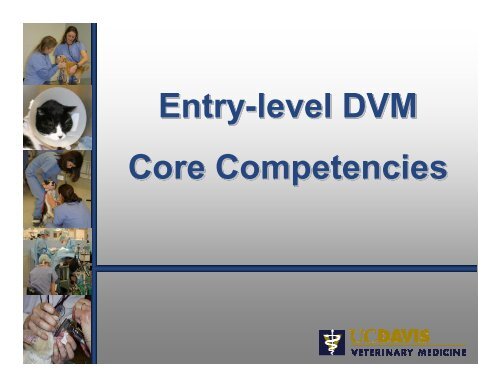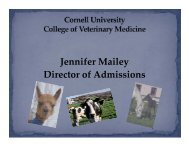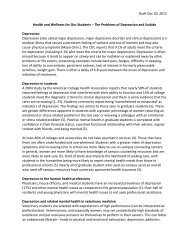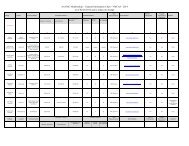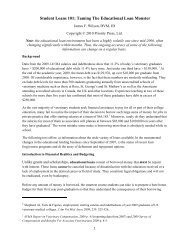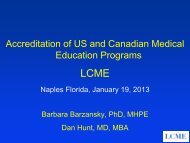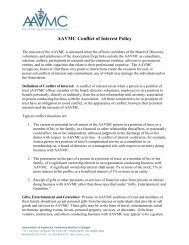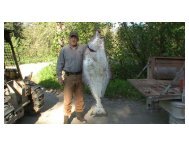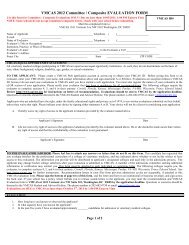Entry-level DVM Core Competencies Entry-level DVM Core ...
Entry-level DVM Core Competencies Entry-level DVM Core ...
Entry-level DVM Core Competencies Entry-level DVM Core ...
Create successful ePaper yourself
Turn your PDF publications into a flip-book with our unique Google optimized e-Paper software.
<strong>Entry</strong>-<strong>level</strong> <strong>DVM</strong><br />
<strong>Core</strong> <strong>Competencies</strong>
Educational Process<br />
Curriculum<br />
Database<br />
Course<br />
Course Learning<br />
Outcomes<br />
Council On Education<br />
Learning Outcomes<br />
<strong>DVM</strong> Learning<br />
Outcomes<br />
Teaching Session<br />
Learning Outcomes<br />
Teaching Session<br />
Top Level<br />
<strong>Competencies</strong><br />
<strong>DVM</strong> <strong>Competencies</strong><br />
Veterinary<br />
On-line<br />
Evaluation<br />
System
<strong>Competencies</strong><br />
Program Competency Domains<br />
- Basic science, paraclinical and clinical knowledge<br />
- Business<br />
- Communication skills<br />
- <strong>Entry</strong>-<strong>level</strong> clinical skills<br />
- Ethics<br />
- Problem solving, critical thinking, life-long learning<br />
- Professionalism<br />
- Public, environmental and animal public health
Learning Outcomes<br />
<strong>Competencies</strong><br />
Domain<br />
Learning Outcomes<br />
Problem solving, critical<br />
thinking and life-long learning<br />
skills<br />
Demonstrate skills and tools necessary to promote lifelong<br />
learning<br />
Access biomedical information and medical records from<br />
electronic databases and other resources<br />
Demonstrate competency in effective problem-solving and<br />
critical thinking<br />
Critically evaluate new knowledge with an understanding<br />
of the basic concepts and principles of scientific<br />
investigation in biomedical sciences
The Process<br />
<strong>Competencies</strong><br />
- Assemble an extensive list of veterinary<br />
competencies<br />
• Lists available from other schools<br />
• List available from the RCVS<br />
• List available from the COE<br />
• Lists available from AAEP<br />
• Lists available from the literature<br />
- Small animal<br />
- Food animal
The Process<br />
<strong>Competencies</strong><br />
- Map the competencies to learning outcomes<br />
- Determine top <strong>level</strong> competencies<br />
- Place the competencies into 4 surveys<br />
• <strong>Core</strong><br />
• Small animal<br />
• Equine<br />
• Food animal<br />
- Ask two groups to take the surveys<br />
• Faculty within the school<br />
• Stakeholders in veterinary practice
<strong>Competencies</strong><br />
An Example of Mapping<br />
Domain Learning Outcomes Top Level<br />
<strong>Competencies</strong><br />
Problem solving,<br />
critical thinking<br />
and life-long<br />
learning skills<br />
Demonstrate skills and tools<br />
necessary to promote life-long<br />
learning<br />
Access biomedical information<br />
and medical records from<br />
electronic databases and other<br />
resources<br />
Demonstrate competency in<br />
effective problem-solving and<br />
critical thinking<br />
Critically evaluate new<br />
knowledge with an<br />
understanding of the basic<br />
concepts and principles of<br />
scientific investigation in<br />
biomedical sciences<br />
Evaluating<br />
information<br />
<strong>Competencies</strong><br />
Critically evaluate a journal<br />
article<br />
Evaluate research data to<br />
broaden knowledge base and<br />
influence patient diagnostic and<br />
treatment plans<br />
Recognize different <strong>level</strong>s of<br />
evidence when evaluating data<br />
relevant to case management
<strong>Competencies</strong><br />
Mapping<br />
Domains<br />
Learning<br />
Outcomes<br />
Top Level<br />
<strong>Competencies</strong><br />
<strong>Competencies</strong><br />
All 7 36 58 880<br />
<strong>Core</strong> 7 21 33 193
<strong>Core</strong> <strong>Competencies</strong><br />
Domain - <strong>Entry</strong>-<strong>level</strong> Clinical Skills<br />
Domain<br />
<strong>Entry</strong>-<strong>level</strong><br />
clinical<br />
skills<br />
Learning Outcomes<br />
Top Level<br />
<strong>Competencies</strong><br />
<strong>Competencies</strong><br />
7 18 128
<strong>Core</strong> <strong>Competencies</strong><br />
Domain – <strong>Entry</strong>-<strong>level</strong> clinical skills<br />
Demonstrate knowledge and skills in handling and<br />
examining animals - handling<br />
Competency<br />
Faculty<br />
(n = 84)<br />
Stakeholders<br />
(n = 37)<br />
Difference<br />
Ensure appropriate hygiene is followed<br />
before and after handling animal/s<br />
100% 97% -3%<br />
Safely catch, handle and restrain 99% 89% - 10%<br />
Describe physical features that are<br />
indicative of temperament/behavior<br />
90% 91% + 1%<br />
Estimate age based on dentition 65% 71% + 6%<br />
Estimate body weight 78% 84% + 6%
<strong>Core</strong> <strong>Competencies</strong><br />
Domain – <strong>Entry</strong>-<strong>level</strong> clinical skills<br />
Demonstrate knowledge and skills in handling and examining<br />
animals - examining<br />
Competency<br />
Faculty<br />
(n = 84)<br />
Stakeholders<br />
(n = 37)<br />
Difference<br />
Perform general physical examination, which<br />
includes observe behavior and temperament,<br />
general physical examination, body condition<br />
score and vital signs (ID heart and breath<br />
sounds, take temperature)<br />
100% 100% 0%<br />
Perform a cardiovascular examination 97% 97% 0%<br />
Perform a respiratory examination 97% 100% + 3%<br />
Perform an orthopedic examination 91% 94% + 3%<br />
Perform an neurologic examination 86% 97% + 11%
<strong>Core</strong> <strong>Competencies</strong><br />
Domain – <strong>Entry</strong>-<strong>level</strong> clinical skills<br />
Demonstrate knowledge and skills in handling and examining<br />
animals - examining<br />
Competency<br />
Faculty<br />
(n = 84)<br />
Stakeholders<br />
(n = 37)<br />
Difference<br />
Perform an ophthalmologic examination 86% 94% + 8%<br />
Perform an dermatologic examination 87% 100% + 13%<br />
Perform an oncologic examination 72% 74% + 2%<br />
Perform a dental examination 87% 94% + 7%<br />
Perform a reproductive examination 74% 74% 0%<br />
Perform a gastrointestinal examination 88% 100% + 12%<br />
Perform a urinary system examination 87% 94% + 7%
<strong>Core</strong> <strong>Competencies</strong><br />
Domain – <strong>Entry</strong>-<strong>level</strong> clinical skills<br />
Develop and apply diagnostic and therapeutic strategies for common<br />
problems identified from the clinical evaluation of the animal -<br />
diagnostic<br />
Competency<br />
Develop a problem list and identify the main<br />
body systems affected<br />
Faculty<br />
(n = 84)<br />
Stakeholders<br />
(n = 37)<br />
Difference<br />
100% 97% -3%<br />
Create differential diagnosis list 99% 97% -2%<br />
Develop a diagnostic plan 100% 97% -3%<br />
Choose appropriate diagnostic tests 100% 94% -6%<br />
Create treatment plan/daily treatment sheet 99% 97% -2%<br />
Order appropriate laboratory tests 97% 94% -3%<br />
Interpret results of laboratory tests obtained 97% 91% -6%
<strong>Core</strong> <strong>Competencies</strong><br />
Domain – <strong>Entry</strong>-<strong>level</strong> clinical skills<br />
Develop and apply diagnostic and therapeutic strategies for common<br />
problems identified from the clinical evaluation of the animal -<br />
therapeutic<br />
Competency<br />
Faculty<br />
(n = 84)<br />
Stakeholders<br />
(n = 37)<br />
Difference<br />
Develop a therapeutic plan 100% 94% -6%<br />
Organize oral summary of case for peers 94% 86% -8%<br />
Follow patient through treatment 96% 94% -2%<br />
Make appropriate referrals supported by<br />
evidence<br />
93% 94% + 1%
<strong>Core</strong> <strong>Competencies</strong><br />
Domain – <strong>Entry</strong>-<strong>level</strong> clinical skills<br />
Demonstrate technical skills used in the diagnosis and management of<br />
diseases – emergency medicine<br />
Competency<br />
Demonstrate assessment and emergency<br />
management of a trauma patient<br />
Recognize and initiate appropriate management<br />
of unconsciousness<br />
Recognize and initiate appropriate management<br />
of shock<br />
Recognize and initiate appropriate management<br />
of external hemorrhage<br />
Faculty<br />
(n = 84)<br />
Stakeholders<br />
(n = 37)<br />
Difference<br />
97% 94% -3%<br />
91% 91% 0%<br />
99% 94% -5%<br />
99% 100% + 1%<br />
Calculate and administer nasal oxygen 73% 79% + 6%<br />
Demonstrate cardiopulmonary resuscitation 93% 91% -2%<br />
Demonstrate stabilization of a fractured limb 97% 94% -3%<br />
Demonstrate limb bandage 99% 94% -5%<br />
Demonstrate wound management 99% 97% -2%
<strong>Core</strong> <strong>Competencies</strong><br />
Domain – <strong>Entry</strong>-<strong>level</strong> clinical skills<br />
Demonstrate technical skills used in the diagnosis and management<br />
of diseases – surgery<br />
Competency<br />
Faculty<br />
(n = 84)<br />
Stakeholders<br />
(n = 37)<br />
Difference<br />
Demonstrate instrument tie 100% 97% -3%<br />
Demonstrate square knot 94% 97% + 3%<br />
Perform one hand surgical tie 61% 71% + 10%<br />
Perform two hand surgical tie 87% 88% -1%<br />
Discuss surgical risk 96% 91% -5%<br />
Demonstrate pack preparation 83% 78% -5%<br />
Demonstrate patient preparation 96% 94% -2%<br />
Demonstrate surgeon preparation 100% 100% 0%<br />
Demonstrate sterile technique 100% 100% 0%<br />
Demonstrate correct instrument handling 99% 100% + 1%
<strong>Core</strong> <strong>Competencies</strong><br />
Domain – <strong>Entry</strong>-<strong>level</strong> clinical skills<br />
Demonstrate technical skills used in the diagnosis and management<br />
of diseases – surgery<br />
Competency<br />
Faculty<br />
(n = 84)<br />
Stakeholders<br />
(n = 37)<br />
Difference<br />
Demonstrate correct tissue handling 100% 100% 0%<br />
Demonstrate proficiency in hemostasis 100% 97% -3%<br />
Demonstrate a range of suture patterns for<br />
abdominal closure<br />
93% 94% + 1%<br />
Demonstrate suture or staple removal 97% 97% 0%<br />
Demonstrate an ovariohysterectomy 97% 88% -9%<br />
Demonstrate a castration 97% 91% -6%<br />
Demonstrate proper postoperative patient<br />
care including wound evaluation<br />
99% 97% -2%<br />
Write a surgery report 96% 94% -2%<br />
Assemble and fit Elizabethan collar 88% 84% -4%<br />
Implant microchip and check function 90% 81% -9%
<strong>Core</strong> <strong>Competencies</strong><br />
Domain – <strong>Entry</strong>-<strong>level</strong> clinical skills<br />
Demonstrate knowledge and skills in the interpretation of common<br />
diagnostic procedures – clinical pathology<br />
Competency<br />
Faculty<br />
(n = 84)<br />
Stakeholders<br />
(n = 37)<br />
Difference<br />
Interpret the results of a gram stain 91% 91% 0%<br />
Interpret the result of a culture and sensitivity 100% 100% 0%<br />
Interpret the results of a skin scraping 92% 100% + 8%<br />
Interpret the results of a complete blood count 100% 100% 0%<br />
Interpret the results of a coagulation panel 94% 94% 0%<br />
Interpret the results of a biochemical analysis 100% 100% 0%<br />
Interpret the results of visual inspection of the<br />
urine<br />
100% 97% -3%<br />
Interpret the results of a chemical reagent strip 99% 100% + 1%<br />
Interpret the results of sediment examination 95% 94% -1%<br />
Interpret the results of a fecal flotation 97% 100% + 3%
<strong>Core</strong> <strong>Competencies</strong><br />
Domain - Communication<br />
Domain<br />
Learning<br />
Outcomes<br />
Top Level<br />
<strong>Competencies</strong><br />
<strong>Competencies</strong><br />
Communication 2 2 8
<strong>Core</strong> <strong>Competencies</strong><br />
Domain – Communication<br />
Demonstrate effective communication of diagnostic and<br />
therapeutic options to clients – client communication<br />
Competency<br />
Faculty<br />
(n = 84)<br />
Stakeholders<br />
(n = 37)<br />
Difference<br />
Identify reason/s for the consultation 95% 97% -2%<br />
Establish rapport with client and animal<br />
taking account of particular communication<br />
needs<br />
95% 97% + 2%<br />
Discuss case progress with client 95% 100% + 5%<br />
Perform follow-up phone calls 91% 97% + 6%<br />
Write discharge instructions 97% 100% + 3%<br />
Provide oral discharge instructions to client 96% 100% + 4%<br />
Obtain written and verbal informed consent 95% 100% + 5%
<strong>Core</strong> <strong>Competencies</strong><br />
Domain - Public, environmental and<br />
population health<br />
Domain<br />
Public,<br />
environmental<br />
and population<br />
health<br />
Learning<br />
Outcomes<br />
Top Level<br />
<strong>Competencies</strong><br />
<strong>Competencies</strong><br />
4 5 19
<strong>Core</strong> <strong>Competencies</strong><br />
Domain – Public, Environmental and Population<br />
Health<br />
Demonstrate knowledge and understanding of the veterinarian’s role<br />
in maintaining and promoting public and animal population health –<br />
population health<br />
Competency<br />
Faculty<br />
(n = 84)<br />
Stakeholders<br />
(n = 37)<br />
Difference<br />
Inspect and evaluate a food production<br />
system for animal health, sanitation and<br />
general biosecurity problems<br />
Evaluate production unit environmental<br />
issues<br />
Demonstrate proficiency in disease outbreak<br />
investigation<br />
Develop a population medicine-based<br />
disease preventive program<br />
Develop a population-based nutritional<br />
program<br />
52% 45% -7%<br />
44% 36% -8%<br />
60% 84% + 24%<br />
60% 68% + 8%<br />
37% 37% 0 %
<strong>Core</strong> <strong>Competencies</strong><br />
Domain – Public, Environmental and Population<br />
Health<br />
Demonstrate knowledge and understanding of the veterinarian’s role in<br />
maintaining and promoting public and animal population health-population<br />
health (continued)<br />
Competency<br />
Faculty<br />
(n = 84)<br />
Stakeholders<br />
(n = 37)<br />
Difference<br />
Establish a population-based reproductive or<br />
population control program<br />
50% 58% + 8%<br />
Establish a biosecurity program 45% 61% + 16%<br />
Establish a population-based vaccination<br />
program<br />
Establish a population-based control program<br />
for internal and external parasites<br />
65% 81% + 16%<br />
65% 81% + 16%<br />
Develop isolation/quarantine plan 72% 84% + 12%<br />
Discuss waste management 61% 68% + 7%
<strong>Core</strong> <strong>Competencies</strong><br />
Domain - Ethics<br />
Domain<br />
Learning<br />
Outcomes<br />
Top Level<br />
<strong>Competencies</strong><br />
<strong>Competencies</strong><br />
Ethics 2 2 2
<strong>Core</strong> <strong>Competencies</strong><br />
Domain – Ethics<br />
Demonstrate knowledge and understanding of ethical<br />
principles that guide decisions affecting individual and<br />
population health – ethical decisions<br />
Competency<br />
Faculty<br />
(n = 84)<br />
Stakeholders<br />
(n = 37)<br />
Difference<br />
Discuss ethical issue 92% 94% + 2%
<strong>Core</strong> <strong>Competencies</strong><br />
Domain – Problem Solving, Critical<br />
Thinking, Life-long Learning<br />
Domain<br />
Problem solving,<br />
critical thinking,<br />
life-long learning<br />
Learning<br />
Outcomes<br />
Top Level<br />
<strong>Competencies</strong><br />
<strong>Competencies</strong><br />
3 3 8
<strong>Core</strong> <strong>Competencies</strong><br />
Domain – Problem Solving, Critical Thinking,<br />
Life-long Learning<br />
Demonstrate skills and tools necessary to promote life-long learning<br />
Competency<br />
Understand and utilize basic themes of<br />
teaching and learning in own learning, and<br />
facilitate learning of others<br />
Demonstrate a commitment to maintaining<br />
professional competence in response to the<br />
developing scientific field and professional<br />
demand<br />
Recognize and work within personal<br />
limitations<br />
Faculty<br />
(n = 84)<br />
Stakeholders<br />
(n = 37)<br />
Difference<br />
78% 80% + 2%<br />
92% 100% + 8%<br />
85% 93% + 8%
<strong>Core</strong> <strong>Competencies</strong><br />
Domain - Professionalism<br />
Domain<br />
Learning<br />
Outcomes<br />
Top Level<br />
<strong>Competencies</strong><br />
<strong>Competencies</strong><br />
Professionalism 2 2 4
<strong>Core</strong> <strong>Competencies</strong><br />
Domain – Professionalism<br />
Work as part of a high-quality, professional healthcare<br />
team with the ability to provide and receive appropriate<br />
constructive criticism, suggestions, and feedback<br />
Competency<br />
Work as part of a team to accomplish<br />
tasks<br />
Able to give feedback in a professional<br />
manner<br />
Able to accept feedback in a<br />
professional manner<br />
Faculty<br />
(n = 84)<br />
Stakeholders<br />
(n = 37)<br />
Difference<br />
93% 90% -3%<br />
93% 100% + 7%<br />
93% 100% + 7%
<strong>Core</strong> <strong>Competencies</strong><br />
Domain - Business<br />
Domain<br />
Learning<br />
Outcomes<br />
Top Level<br />
<strong>Competencies</strong><br />
<strong>Competencies</strong><br />
Business 1 1 3
<strong>Core</strong> <strong>Competencies</strong><br />
Domain – Business<br />
Demonstrate basic knowledge of small business<br />
management and economics - client<br />
Competency<br />
Faculty<br />
(n = 84)<br />
Stakeholders<br />
(n = 37)<br />
Difference<br />
Provide cost estimates for clients 91% 90% -1%<br />
Calculate costs of procedures<br />
and diagnostics for clients<br />
91% 90% -1%<br />
Calculate client bill 84% 90% + 6%
<strong>Core</strong> <strong>Competencies</strong><br />
Correlation Coefficient between Faculty and<br />
Stakeholder Determinations (r 2 = 0.91)<br />
Stakeholder<br />
Faculty
Next Steps<br />
<strong>Core</strong> <strong>Competencies</strong><br />
• Faculty committee to determine core<br />
competency <strong>level</strong> for all 4 groups<br />
• If <strong>level</strong> set at >80% for both faculty and<br />
stakeholders for core competencies<br />
Domains<br />
Learning Outcomes Top Level<br />
<strong>Competencies</strong><br />
<strong>Competencies</strong><br />
7 21 33 193<br />
7 21 30 172


